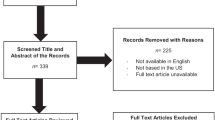Abstract
Latino individuals comprise 18% of the US population, but they account for 26% of new HIV infections, 22% of people living with HIV/AIDS, and 23% of new AIDS diagnoses. These disparities are driven mainly by a persistently high number of new infections among Latino men who have sex with men in less than a dozen states and US territories. The current HIV care continuum for Latinos falls short of national and international goals and threatens to perpetuate the epidemic. Improving outcomes and eliminating new HIV infections will require a focus on various internal and external factors affecting Latino communities.
Access this chapter
Tax calculation will be finalised at checkout
Purchases are for personal use only
Similar content being viewed by others
References
Noe-Bustamante L, Flores A. Facts on Latinos in the U.S. September 16 2019. https://www.pewresearch.org/hispanic/fact-sheet/latinos-in-the-u-s-fact-sheet/.
U.S. Census Bureau. 2017 National population projections tables. 2017. https://www.census.gov/data/tables/2017/demo/popproj/2017-summary-tables.html.
Krogstad JM, Noe-Bustamante L. 7 facts for national Hispanic heritage month. October 14 2019. https://www.pewresearch.org/fact-tank/2019/10/14/facts-for-national-hispanic-heritage-month/.
U.S. Census Bureau. Population by race and Hispanic or Latino origin for the United States, regions, divisions, states, Puerto Rico, and places of 100,000 or more population (PHC-T-6). April 2 2001. https://www.census.gov/population/www/cen2000/briefs/phc-t6/index.html.
Pew Research Center. Hispanic population and origin in select U.S. metropolitan areas, 2014. September 6 2016. https://www.pewresearch.org/hispanic/interactives/hispanic-population-in-select-u-s-metropolitan-areas/.
Lopez MH, Dockterman D. U.S. Hispanic country of origin counts for nation, top 30 metropolitan areas. May 26 2011. https://www.pewresearch.org/hispanic/2011/05/26/us-hispanic-country-of-origin-counts-for-nation-top-30-metropolitan-areas/
Flores A. How the U.S. Hispanic population is changing. September 18 2017. https://www.pewresearch.org/fact-tank/2017/09/18/how-the-u-s-hispanic-population-is-changing/.
Flores A. Hispanic population in the United States statistical portrait. 2015. September 18 2017. https://www.pewresearch.org/hispanic/2017/09/18/2015-statistical-information-on-hispanics-in-united-states/#hispanic-pop.
Ryan CL, Bauman K. Educational attainment in the United States: 2015. March 2016. https://www.census.gov/content/dam/Census/library/publications/2016/demo/p20-578.pdf.
Matthews TJ, Hamilton BE. Total fertility rates by state and race and Hispanic origin: United States, 2017. National Vital Statistics Reports; vol 68 no 1. Hyatssville: National Center for Health Statistics. p. 2018.
Edwards A. U.S. Hispanic poverty rate hit an all-time low in 2017. U.S. Census Bureau. February 27 2019. https://www.census.gov/library/stories/2019/02/hispanic-poverty-rate-hit-an-all-time-low-in-2017.html.
Humes KR, Jones NA, Ramirez R. Overview of race and Hispanic origin. 2010. 2010 Census Briefs; C2010BR-02. U.S. Census Bureau. March 2011.
Pew Research Center. Multiracial in America: proud, diverse, and growing in numbers. Washington, D.C.: June 2015.
Centers for Disease Control and Prevention. HIV and Hispanics/Latinos. October 15, 2019. https://www.cdc.gov/hiv/group/racialethnic/hispaniclatinos/index.html.
Centers for Disease Control and Prevention. HIV among Latinos. https://www.cdc.gov/nchhstp/newsroom/docs/factsheets/cdc-hiv-latinos-508.pdf.
Volpi C, Cahill S. Retaining transgender women in HIV care: best practices in the field. Boston: The Fenway Institute; 2018.
Centers for Disease Control and Prevention. HIV and transgender communities. April 2019. https://www.cdc.gov/hiv/pdf/policies/cdc-hiv-transgender-brief.pdf.
Centers for Disease Control and Prevention. HIV and transgender people. September 6, 2019. https://www.cdc.gov/hiv/group/gender/transgender/index.html.
U.S. Department of Health and Human Services Office of Minority Health. HIV/AIDS and Hispanic Americans. January 17, 2018. https://minorityhealth.hhs.gov/omh/browse.aspx?lvl=4&lvlid=66
Centers for Disease Control and Prevention. HIV and pregnant women, infants, and children. September 6, 2019. https://www.cdc.gov/hiv/group/gender/pregnantwomen/index.html.
Centers for Disease Control and Prevention. HIV surveillance report: diagnoses of HIV infection in the United States and dependent areas, 2017. Vol 29. November 2018. https://www.cdc.gov/hiv/pdf/library/reports/surveillance/cdc-hiv-surveillance-report-2017-vol-29.pdf.
Kaiser Family Foundation. Latinos and HIV/AIDS. April 15, 2014. https://www.kff.org/hivaids/fact-sheet/latinos-and-hivaids/.
Center for Latino Adolescent and Family Health. The invisible crisis: HIV among Hispanics/Latinos in the United States. 2019. https://drive.google.com/file/d/19c-vXMte97_RPMb4alcaiV1A2GMUuyHt/view.
Centers for Disease Control and Prevention. HIV in the United States by region. September 9 2019. https://www.cdc.gov/hiv/statistics/overview/geographicdistribution.html.
Centers for Disease Control and Prevention (CDC). Geographic differences in HIV infection among Hispanics or Latinos – 46 states and Puerto Rico, 2010. JAMA. 2012;308(23):2450–2.
Centers for Disease Control and Prevention. HIV and youth. September 9 2019. https://www.cdc.gov/hiv/group/age/youth/.
Diaz RM. Latino gay men and HIV: culture, sexuality, and risk behavior. New York: Routledge; 1998.
Gant Z, et al. HIV care outcomes among Hispanics or Latinos with diagnosed HIV infection – United States, 2015. MMWR. 2017;66(40):1065–72. https://www.cdc.gov/mmwr/volumes/66/wr/pdfs/mm6640a2.pdf.
Levison JH, et al. “Where it falls apart”: barriers to retention in HIV care in Latino immigrants and migrants. AIDS Patient Care STDs. 2017;31(9):394–405.
HIV and Latinos. POZ Magazine. March 19, 2018. https://www.poz.com/basics/hiv-basics/hiv-latinos.
U.S. Department of Health and Human Services, Office of Minority Health. Profile: Hispanic/Latino Americans. August 22, 2019. https://minorityhealth.hhs.gov/omh/browse.aspx?lvl=3&lvlid=64.
Lally MA, et al. HIV continuum of care for youth in the United States. J Acquir Immune Defic Syndr. 2018;77(1):110–7.
U.S. Department of Health and Human Services. HIV prevention activities. May 20 2017. https://www.hiv.gov/federal-response/federal-activities-agencies/hiv-prevention-activities.
Centers for Disease Control and Prevention. HIV prevention pill not reaching most Americans who could benefit – especially people of color. March 6, 2018. https://www.cdc.gov/nchhstp/newsroom/2018/croi-2018-PrEP-press-release.html.
Page KR, et al. Promoting pre-exposure prophylaxis to prevent HIV infections among sexual and gender minority Hispanics/Latinxs. AIDS Educ Prevent. 2017;29(5):389–400.
U.S. Department of Health and Human Services. What is ‘ending the epidemic: a plan for America’? September 3, 2019. https://www.hiv.gov/federal-response/ending-the-hiv-epidemic/overview.
League of United Latin American Citizens. Latino health disparities. 2014. https://lulac.org/programs/health/health_disparities/.
Health Resources and Services Administration. HRSA’s Ryan White HIV/AIDS program population fact sheet. August 2019. https://hab.hrsa.gov/sites/default/files/hab/Publications/factsheets/population-factsheet-hispanic.pdf9.
Author information
Authors and Affiliations
Corresponding author
Editor information
Editors and Affiliations
Rights and permissions
Copyright information
© 2021 Springer Nature Switzerland AG
About this chapter
Cite this chapter
González, A. (2021). HIV/AIDS and the Latino Populations in the United States: Epidemiology, Prevention, and Barriers to Care and Treatment. In: Ojikutu, B., Stone, V. (eds) HIV in US Communities of Color. Springer, Cham. https://doi.org/10.1007/978-3-030-48744-7_5
Download citation
DOI: https://doi.org/10.1007/978-3-030-48744-7_5
Published:
Publisher Name: Springer, Cham
Print ISBN: 978-3-030-48743-0
Online ISBN: 978-3-030-48744-7
eBook Packages: MedicineMedicine (R0)




